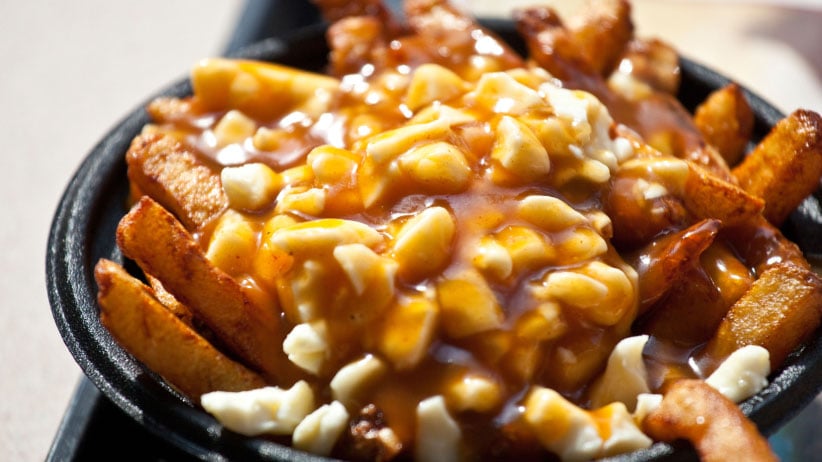Why poutine is Canada’s most delicious mess
Canada is a nation divided by its favourite foods. Poutine bridges the gap, and its popularity is rising.
Poutine at La Belle Province restaurant in Montreal, Canada. (dbimages/Alamy)
Share

The message buried in the results of our national poll on Canadians’ favourite homegrown foods may seem elusive. But study those national and regional results a little more closely, as I have, and a clear national consensus emerges. It is simply this: when Canadians are hungry, they are grateful they’ve got Quebec.
[widgets_on_pages id=98]
Sure, at first glance you might disagree, pointing out instead that the No. 1 item on the list—poutine—clinches the top spot with only tepid (21 per cent) national support. And you might well also add a discouraging note, which is that, as is too often the case in this country, regional enthusiasms run twice as hot as national consensus. Take Alberta, where 41 per cent of the populace voted for the province’s own beef as the most prized, iconic food in the country, or the Atlantic provinces, where 30 per cent cast their vote for lobster.
But hang on. When you look at those results nationally, Alberta beef slips to just nine per cent. And while lobster sits at 10 per cent, part of the reason the disparity between local and national results is not as great with this product as it is with beef is that the Atlantic provinces don’t have a monopoly on it. In Quebec, when they vote for lobster they’re voting for their own—the ones with the fleur-de-lys embossed on the rubber bands binding their claws.
So, of the three single items to crack double-digit national popularity (poutine, maple syrup, lobster), two are emphatically Québécois, and one at least partly so. Next in national popularity comes Alberta beef, then Montreal smoked meat.
MORE FROM THE CANADA PROJECT: A two-four of facts for Canada 150
If you’re paying careful attention, you will have noticed that these top-five-ranked items are not alike. Two of them (beef and lobster) are just raw products. Whether they taste good depends entirely on what you do with them. And as they are—raw and untampered with—no one in the rest of the world would recognize them as Canadian.
But the other three—our national prepared foods—are readily identifiable as such. And, for better or worse, they all hail from Quebec.
The reasons for this are too complicated to explore in detail here. Usually people put it down to Quebec’s head start on much of the country, and the unusually symbiotic relationship—culinarily speaking—of our two founding cultures. But the evidence of our poll seems to refute this: one of the three items is neither English nor French, but of Jewish, and likely Bessarabian, origin. And our top item, poutine, is only a tick over a half-century old. But in popularity, the newcomer already routs that seminal, centuries-old English- and French-inspired meat pie, tourtière, by a ratio of five to one.

And poutine is only getting more popular. To be precise, its appeal doubles every generation. Only nine per cent of Boomers give it the nod, but that rises to 20 per cent with Gen Xers, and a staggering 43 per cent of Millennials. If the trend continues, the children of the latter group will eat little else.
Its popularity also defies borders. It’s been more than a decade since it took New York (thanks in some large part to Au Pied de Cochon alumnus Hugue Dufour and his M. Wells restaurants), and then poutine branched out to Boston and Chicago. It even enjoys some popularity in the U.K., where, from Torontonian Paul Dunits’s Poutinerie stall in Brick Lane, it progressed to chip shops in Glasgow, and from there onto the menu at such places as the posh steakhouse Hawksmoor.
READ MORE: 12 foods Canada has given the world (besides poutine)
As a Canadian—and, especially, as a Quebecer—you may consider this a source of pride. Or you may take it as cause for concern (for example, when the Guardian ran a story a few years back titled “Poutine: the posh chips and gravy taking over the world,” its accompanying photo provoked the online comment, “You often see this, or something similar, on the pavement near the pub”). But wherever you stand on its actual consumption, you must tip your hat to its success. And wonder about what it is, exactly, that accounts for its boundless appeal. What makes poutine so great?
Evidently, the dish hits all markers. It is simultaneously familiar (everyone knows and loves french fries, with a sauce to dip them in) and new (adding the twist of a seductive squeak against the tooth from that fresh cheese curd). It is also cheap, filling and infinitely adaptable, especially upmarket (well, you can’t very well take it down). It all seems perfectly obvious, really—until you try to invent something similarly winning yourself.
